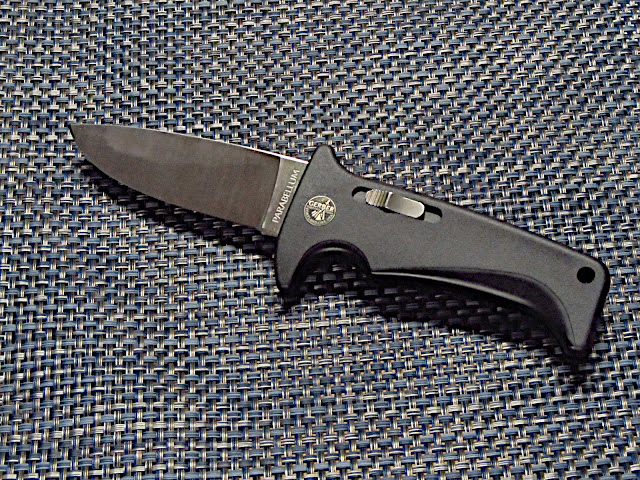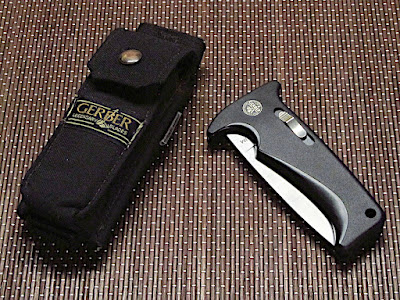I’m not a huge fan of club knives. Most club knives have a simple engraved blade and little else to recommend them. However, I do occasionally purchase them. My local club, Western Reserve Cutlery Association, had a swing guard with an ivory handle from Keen Kutter that I bought. By comparison, most current club knives seem ordinary.
 |
| WRCA Club Knife...They forgot to have the year engraved. |
Recently I found a Gerber NKCA knife from 1986. It was number 3013 of 6200. The raised NKCA shield over the blade pivot caught my eye, as did the excellent brown jigging and engraved blade.
NKCA stands for National Knife Collectors Association.
 |
| 1986 NKCA Club Knife one of 6200. That number amazes me! |
You don’t hear much about the NKCA anymore. I googled their name and found a website selling cheap chewtoy holsters. You take the metal parts off, if any, and give the holster to your dog to chew on.
NKCA started in 1972 when a group of collectors/dealers working at knife shows in Kentucky and Tennessee realized there was a growing market of knife enthusiasts and collectors. They decided to form an association to grow a hobby into a profitable (keyword profitable) business.
It shouldn’t surprise you to discover the original name was the National Knife Collectors & Dealers Association. After a couple of years, the dealer part was dropped. Too much honesty, I guess.
James F. Parker was the first elected president in 1972. He was a leading knife dealer at the time. Parker was an interesting fellow. James F. Parker founded Parker Knife Company as a sideline to his employment as a paint sales rep. He was one of the first to effectively utilize direct mail services to buy and sell collectible knives in the 1970s. Parker helped start Frost Cutlery by partnering with James Frost in a short-lived partnership and owned Case knife for a short time.
Parker guided the development of the NKC&DA to include enrolling members nationwide with a yearly membership fee. They received a small monthly newsletter which developed into a monthly magazine.
1974 was two years into his presidency and Parker thought outside the box. He proposed a "Collector's Knife" to be made exclusively for members. Essentially, Parker originated the almost universal club knife, primarily to promote membership and a degree of eliteness. Only members could buy a limited-edition knife from the NKC&DA. This was unheard of at the time! That factor drove the desire to be able to own one of these knives to high demand!
Parker chose an Anglo-Saxon whittler pocket knife with the most desired Case XX pattern 6391. But Parker had difficulty finding a U.S. manufacturers willing to make the 1200 knives.
Howard Rabin of Star Sales in Knoxville, TN, stepped up. Rabin was the U.S. importer of German-made Kissing Crane knives. His company wanted to be part of this new venture and eagerly made the 1200 knives Parker asked for.
For fun, I've converted the prices to 2023 dollars in parentheses. The days of buying a new quality pocket knife for under $20 are gone.
NKC&AD sold their first club knives for $12 ($73) and only one knife per member. They didn’t sell out as anticipated. Being savvy or perhaps desperate businessmen, they created a second offer to their members. Each member could now order up to three knives each at $15 ($83).
Thus began club knives being used for promotion and as fundraisers.
 |
| Sold in 1986 for the equivalent of $106 |
In 1975, the desire for these limited edition NKC&AD club knives pushed the knife price to a staggering resale price of $600 ($3336). The 1976 club knife, a Case XX 4380 whittler with a production of 5,000, would sell out! The price of $15 ($83) would peak at a resale value of $250 ($1390). The 1977 club knife was a Kissing Crane stag handled gunboat canoe knife and 6,000 were produced, followed in 1978 by 8,000 IXL Wostenholm green bone handled three blade canoes. The peak number of knives produced for NKCA was in 1981 with an issue of 12,000 made by Queen.
That was high point of NKCA club knives. NKCA membership started to decline as did the number of annual club knives produced.
Regional clubs wanted their own club knives, and the uniqueness and potential for up-market sales decreased. Soon, various regional clubs had copied all the rare vintage and unusual patterns. Clubs would try many variations by changing the handle materials, shifting blades around, adding blades to existing patterns, etc. Nothing worked as well as the early revival of long discontinued vintage patterns originated by Parker and the NKCA.
There were so many club knives that it made it almost impossible to collect them all. The oversupply had affected the value of the knives.
Soon the resale value of a club knife was the same as the knife without the club markings.
In the end, the NKCA folded. The exact date seems hard to determine.
There are still more than enough hard feelings to go around. In 2010 an NKCA life member posted on Blade Forum:
“The NKCA became a slick scam by a series of office managers and presidents and sgt. at arms and various other 'officials' who helped to bankrupt what was a 3,500-member organization with a brick-and-mortar, state-of-the-art museum that I am grateful to have visited once. Jim Parker, bless his soul, bought the land for 50 thousand and built the museum. The thieves and scoundrels; yes, you heard right, going back to the thief who never delivered the pearl-handled 'club' knife forced the closure of the museum and the sale of the museum property for 1 million, all of which went to pay the NKCA's debts. They should all have been 'hung'; both men and women!"
So, club knives? Are they a scam? A gimmick to make money and attract members?
Maybe, but I suggest you buy based on what you like and not a financial investment. The 1986 NKCA knife was sold for $39.00 or $106 in 2023 dollars. I found my knife for around $50, but I see others trying to sell at $125 and they collect dust.
 |
| Will the WRCA club knife increase in value or just get lost of the ubiquitousness of club knives? |





